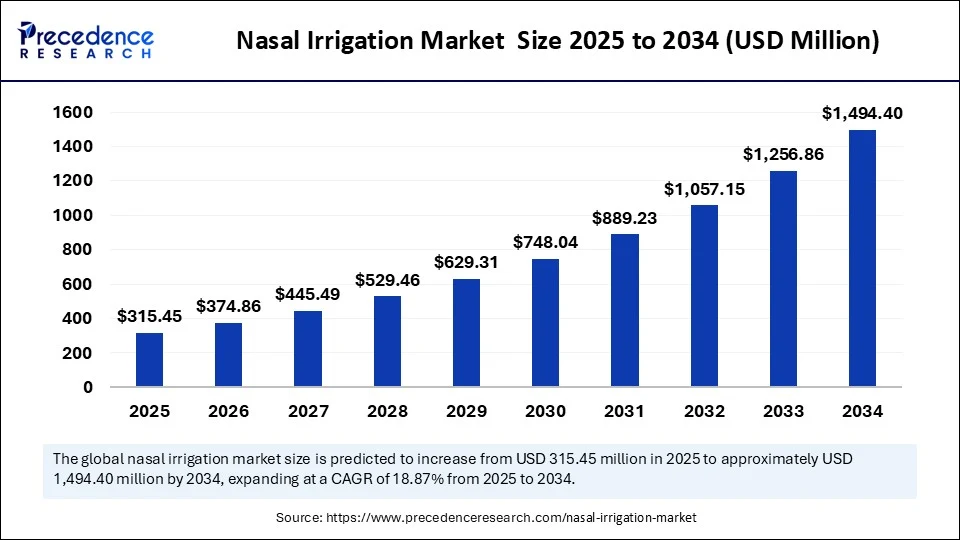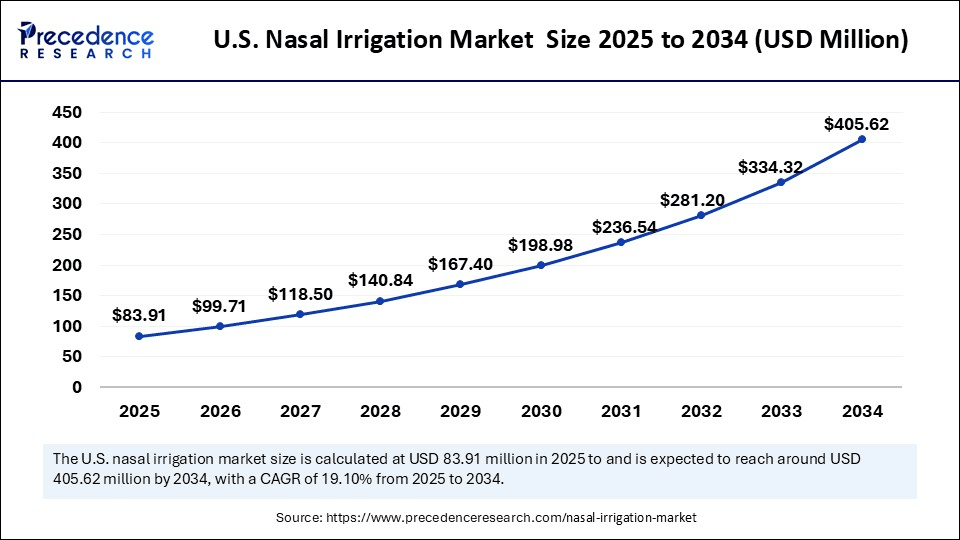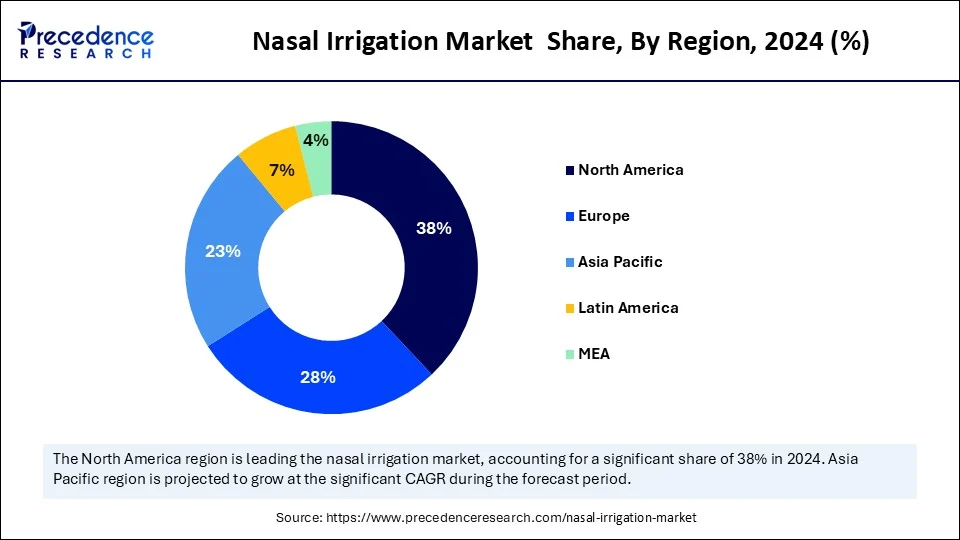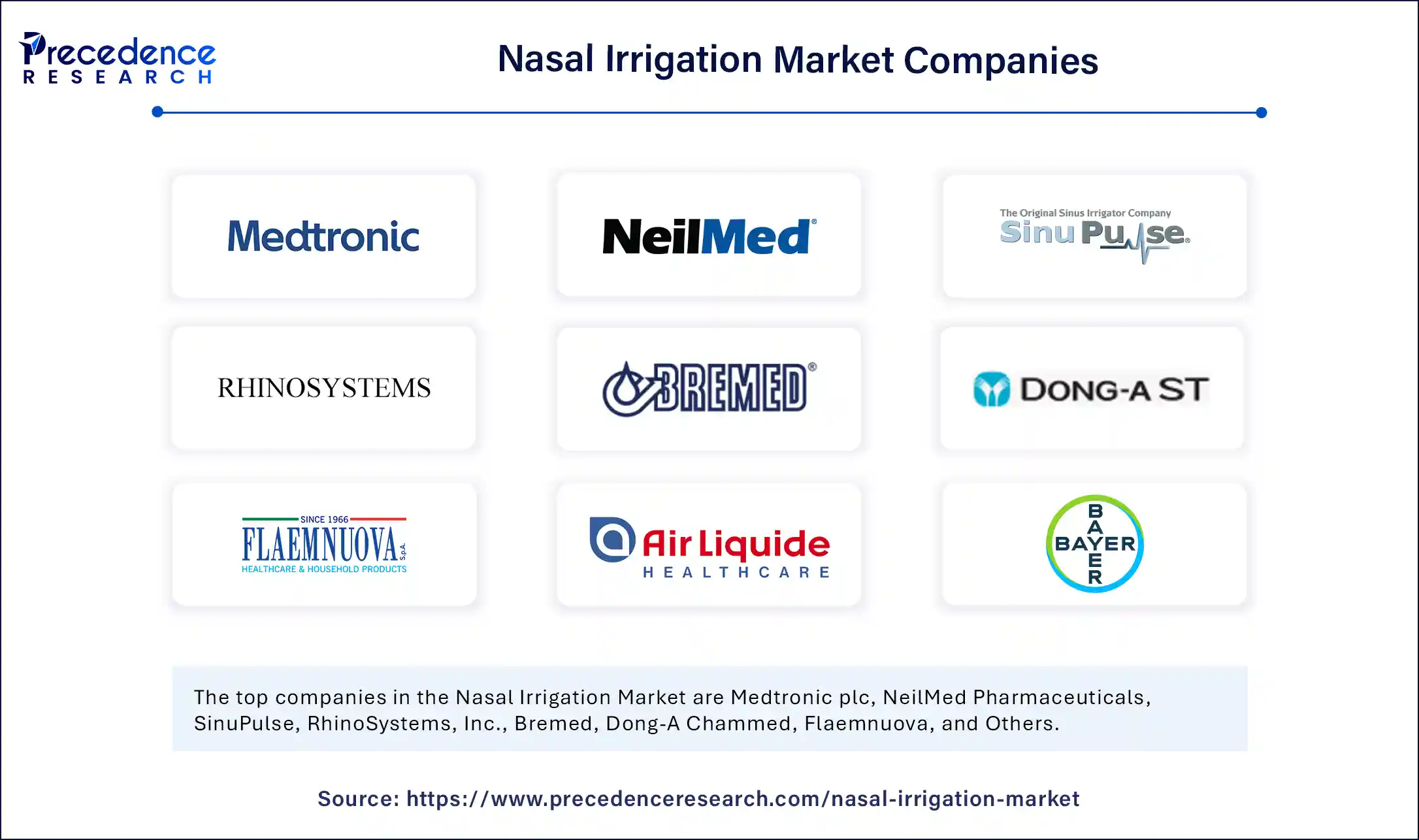List of Contents
Nasal Irrigation Market Size and Forecast 2025 to 2034
The global nasal irrigation market size accounted for USD 265.47 million in 2024 and is predicted to increase from USD 315.45 million�in 2025 to approximately USD 1,494.40 million by 2034, expanding at a CAGR of 18.87% from 2025 to 2034. The nasal irrigation market is growing due to a growing awareness of sinus health, increasing prevalence of allergies and respiratory conditions, and a preference for non-invasive, at-home treatments with immediate and effective relief of symptoms.

Nasal Irrigation Market�Key Takeaways
- The global nasal irrigation market was valued at USD 265.47 million in 2024.
- It is projected to reach USD 1,494.40 million by 2034.
- The market is expected to grow at a CAGR of 18.87% from 2025 to 2034.
- North America dominated the nasal irrigation market with the highest share of 38% in 2024.
- Asia Pacific is expected to expand at the fastest CAGR between 2025 and 2034.
- By product type, the neti pot segment held the largest market share in 2024.
- By product type, the baby bulb syringe segment is anticipated to grow at a remarkable CAGR between 2025 and 2034.
- By technology, the manual nasal irrigators segment captured the biggest market share in 2024.
- By technology, the electric/battery-powered nasal irrigators segment is expected to expand at the fastest CAGR over the projected period.
- By patient type, the adults segment contributed the highest market share in 2024.
- By patient type, the pediatrics segment is expected to expand at a significant CAGR over the projected period.
- By application, the sinusitis segment generated the major market share in 2024.
- By application, the rhinitis segment is expected to expand at the fastest CAGR over the projected period.
- By end-user, the hospitals & clinics segment accounted for significant share in 2024.
- By end-user, the homecare settings segment is expected to expand at the highest CAGR over the forecast period.�
Impact of Artificial Intelligence on the Nasal Irrigation Market?
Artificial intelligence (AI) is revolutionizing the nasal irrigation market by enabling personalized treatment and enabling the development of smart nasal irrigation devices. Integrating AI-enabled sensors in nasal irrigation devices modifies water pressure and flow based on user preference or sinus sensitivity. AI-driven smart irrigation devices can be connected to mobile applications that can track user habits and recommend personalized routines depending on whether patients have sinusitis or allergic rhinitis. These devices also track symptoms or voice instructions to facilitate user compliance, particularly for elderly users. In addition, AI algorithms analyze respiratory health data to identify early warning signs of allergies or sinus infections which may be an indicator for nasal irrigation. AI can make nasal care more proactive, user-enabled, and efficacious for chronic nasal conditions.
U.S. Nasal Irrigation �Market Size and Growth 2025 to 2034
The U.S. nasal irrigation market size was exhibited at USD 70.62 million in 2024 and is projected to be worth around USD 405.62 million�by 2034, growing at a CAGR of 19.10% from 2025 to 2034.

What Made North America the Dominant Region in the Nasal Irrigation Market?
North America registered dominance in the market by holding the largest share in 2024. This is mainly due to its advanced healthcare infrastructure, high levels of awareness about respiratory hygiene, and large availability of over-the-counter nasal care products. Increased incidence of sinus-related issues, such as chronic rhinosinusitis, among the population has led to a higher rate of yawners and awareness and adoption of at-home nasal care practices. The rise in consumer preference for non-drug, preventative practice approaches has also contributed to the increased usage of saline-based irrigation devices.
The U.S. is a major contributor to the North American nasal irrigation market. The presence of major manufacturers such as NeilMed Pharmaceuticals and Waterpik have further bolstered innovation and product efficacy/reliability while simultaneously contributing to prevailing levels of trust among consumers. These companies continue to ramp up production and global distribution in response to the rise in consumer demand. There has been an uptick in nasal irrigators use among allergenic patients. The presence of widespread retail pharmacy networks is boosting accessibility to over-the-counter products, supporting market growth.
European Nasal Irrigation Market Trends
Europe was the second-largest shareholder in 2024 and is expected to grow at a notable rate in the upcoming period. This is mainly due to the rising health-conscious population in this region. Consumers are increasingly using nasal irrigation for allergy prevention, easing cold symptoms, and general sinus care. The transition to nasal rinse therapies has increased as a result of a strong focus on natural therapies and the inclusion of nasal rinsing as a best practice recommendation from ENT specialists. Furthermore, in many Western and Northern European countries, a significantly strong pharmacy network and the availability of sinus health products support regional market growth.
Germany is leading the market within Europe. There is heightened consumer awareness for nasal hygiene as well as a preference for evidence-based natural therapies. German consumer are more likely to integrate nasal rinsing into their allergy and cold care practices, particularly in pollen season. A clear regulatory framework promoting these products' safety and efficacy also helps maintain consumer confidence. Many German pharmacies and online retailers provide a variety of nasal irrigation systems, including neti pots and electric flushers, catering to a large number of potential users ranging in all ages.

Asia Pacific Nasal Irrigation Market Trends
Asia Pacific is expected to grow at the fastest CAGR during the projection period due to increasing air pollution levels and rising interest in alternative healthcare products. Countries like China and India have reported increasing prevalence of respiratory and allergy-related conditions, especially among children. With the growing disposable income and increased access to online health products, more people are incorporating nasal rinsing into their daily routine with the aim of improving wellness.
China is a leading player in the market. Pediatricians and ENT doctors are recommending nasal irrigation as a public health policy due to air pollution, pollen counts, and seasonal allergy peaks. The adoption of nasal irrigation is also made easier by historically traditional methods of sinus cleaning that are very much in line with saline rinses today. Many domestic brands are now creating portable, electric nasal rinse kits for family use and are selling through JD.com and Alibaba. Government focuses on improving public respiratory health following COVID-19, which is expected to drive the growth of the market.
Market Overview
Nasal irrigation is a therapeutic treatment involving the rinsing of the nasal cavity using saline solutions or medicated solutions to remove mucus and other debris, including allergens, from the nasal passage. The nasal irrigation treatment is often performed with neti pots, squeeze bottles, or pressurized spray systems. Nasal irrigation can help alleviate chronic illnesses such as sinusitis, allergies, and the common cold and loosen nasal congestion that requires moisture and irrigation to be managed.
The rising awareness of non-pharmacologic treatments is driving the growth of the nasal irrigation market. The increase in the number of people experiencing signs and symptoms of chronic sinusitis and allergies is boosting the demand for nasal irrigation therapy. Moreover, the increasing development of innovative nasal irrigation devices, growing awareness of self-service/self-care at home, and increased referrals by ENT specialists to their patients are all contributing to the market growth.
Nasal Irrigation Market�Growth Factors
- Increasing Sinus and Allergy Cases: The rising incidence of sinusitis and allergic rhinitis on a global scale is driving the demand for nasal irrigation as a safe and effective way to relieve nasal congestion and nasal irritation.
- Preference for Non-Drug Solutions: Consumers are preferring non-drug options to bypass the side effects associated with medications, and, thus, have begun using saline-based nasal rinses as a natural alternative to restore respiratory relief.
- New Device Developments: Manufacturers are introducing nasal irrigation devices with transformational improvements, like pressure control and ergonomic designs, enhancing convenience and appeal for a broader user group.
- Demand for Home-Based Care: The growing trends of home healthcare and self-care and treatments are contributing to growth in the use of nasal rinse kits, which are easy to use anytime during cold, flu and allergy seasons.
- Endorsement by Healthcare Professionals:�Usually, including an ENT specialist's recommendation and health organization recommendations or growing awareness of nasal irrigation with health organizations' advocacy for nasal irrigation will encourage more routine use of nasal irrigation products among adults and children alike.
Market Scope
| Report Coverage � � � | Details |
| Market Size by 2034 | USD 1,494.40 Million |
| Market Size in 2025 | USD 315.45 Million |
| Market Size in 2024 | USD 265.47 Million |
| Market Growth Rate from 2025 to 2034 | CAGR of 18.87% |
| Dominating Region | North America |
| Fastest Growing Region | Asia Pacific |
| Base Year | 2024 |
| Forecast Period | 2025 to 2034 |
| Segments Covered | Product Type, Technology, Patient Type, Application, End-User and Region |
| Regions Covered � � | North America, Europe, Asia-Pacific, Latin America, and Middle East & Africa |
Market Dynamics
Drivers
Increasing Sinus Conditions
One of the major factors driving the growth of the nasal irrigation market is the rise in the incidence of sinus infections, nasal allergies, and post-viral respiratory infections. In 2024, healthcare professionals across the U.S. and Europe reported surges in chronic rhinosinusitis, nasal obstruction from allergies, and worsening nasal symptoms exacerbated by viral illnesses such as COVID-19 and the seasonal flu. The result has been an increase in patients using nasal irrigation systems instead of drugs or as an adjunct treatment option for home-based care.
ENT specialists are now openly endorsing saline-based nasal rinsing systems, including neti pots and electric nasal irrigators, to improve inflammation and obstruction in the nasal cavity. The combination of more health-related respiratory distress and clinical endorsement is steadily driving more consumers to use these devices and manage sinus disorders. The rise in allergies and infections further boosts the growth of the market.
Restraint
Limited Awareness and Misuse Restrict Market Penetration
A significant factor restricting the growth of the nasal irrigation market is limited knowledge about the proper use of nasal irrigation devices. Even with the high availability of nasal irrigation systems, many users, especially in developing countries and semi-urban areas, lack knowledge about the safe and effective use of these systems. Improper use can lead to complications. Nasal discomfort, irritation, or infection are common side effects, which often occur from compounded incorrect techniques or using non-sterile water. �According to the report of NIH, side effects noted by about 10% saline nasal irrigation (SNI) users include self-limited ear fullness, stinging of the nasal mucosa, and epistaxis. Moreover, in several countries, nasal rinsing is still not engrained or is not widely recommended, which limits the mass acceptance of nasal irrigation devices.
(Source: https://pmc.ncbi.nlm.nih.gov)�
Opportunity
How is Online Retail Supporting the Nasal Irrigation Market?
A major opportunity for the growth of the nasal irrigation market lies in the rapid growth of e-commerce and digital health platforms. With smartphones and internet connectivity growing, particularly in emerging economies, consumers now have easy access to numerous nasal hygiene products. Nasal irrigation devices are marketed through digital marketing and influencer campaigns. Popular brands like Nav�ge and SinuPulse have already capitalized on the trend, with their irrigation monitors, Bluetooth compatibility, and mobile apps attracting tech-savvy, health-conscious users. Subscription models encourage repeat purchases. With the rapid expansion of digital and e-commerce platforms, accessibility to nasal irrigation products is rising.
Product Type Insights
Why Did Neti Pot Segment Dominate the Nasal Irrigation Market in 2024?
The Neti pot segment dominated the market with the largest share in 2024. This is mainly due to its crucial role in effectively managing sinuses. Neti pots are simple to use and economically priced. They are gravity-based irrigation devices that easily flush out nasal congestion and allergens compared to their counterparts. They remain the predominant product used, especially for those who want the most natural way to manage their sinus issues. They are also readily available in pharmacies and online. Interestingly, very few skills are needed to operate a neti pot, which appeals to those consumers looking for low-cost, self-managed options.
Meanwhile, the baby bulb syringe segment is expected to grow at a significant CAGR during the forecast period. This is mainly due to the rising instances of nasal congestion in infants. Baby bulb syringes are mostly intended for infants. They help babies breathe by clearing nasal passages. They have special advanced irrigation features; nonetheless, they are still expensive compared to a neti pot.
Technology Insights
What Made Manual Nasal Irrigators the Dominant Segment in 2024?
The manual nasal irrigators segment dominated the nasal irrigation market with a major share in 2024 due to their user-friendliness, cost-effectiveness, and high patient compliance. Manual nasal irrigators include devices such as squeeze bottles and neti pots that rely on locally based gravity. Manual nasal irrigators give users more control of the irrigation process because they don't require electrical power, except when made battery operated. Manual nasal irrigators are a staple in nasal irrigation treatments due to their longevity and consumer trust.
The electric/battery-powered nasal irrigators segment is expected to expand at the fastest CAGR over the projected period. The growth of the segment is attributed to the rising consumer preferences for smart devices. Ongoing advancements in battery technology are improving the functionality of electric�battery-powered nasal irrigators. Many designs now come with adjustable pressure and features such as pulsation. As consumers increasingly demand health devices that automate tasks, the demand for battery and electricity-powered nasal irrigators is likely to increase in the coming years.
Patient Type Insights
Why Did Adults Segment Dominate the Market in 2024?
The adults segment dominated the nasal irrigation market in 2024. Adults are the dominant patient group utilizing nasal irrigation for several practical reasons. Firstly, a higher proportion of adults suffer from sinusitis, allergies, and work-related pollutant exposures, boosting the need for nasal irrigators. Secondly, adults have a greater tendency to use nasal rinsing in a non-pharmacological manner, either as a hygienic procedure or as a part of allergy treatment. At last, adults have the ability to self-administer the devices and not require assistance, boosting the adoption of nasal irrigators.
The pediatrics segment is expected to expand at a significant CAGR over the projected period as children often experience nasal congestion. While pediatric indications are expanding, especially for the treatment of bronchiolitis and allergies, caregivers are somewhat hesitant to use nasal irrigators on children because they worry about using them safely. The emergence of more pediatric-specific devices and alternatives is boosting the growth of the segment. Moreover, the rising awareness of the benefits of nasal hygiene among parents is boosting the adoption of nasal hygiene products for their children.
Application Insights
How Does Sinusitis Segment Dominate the Nasal Irrigation Market in 2024?
The sinusitis segment dominated the market by capturing the biggest revenue share in 2024. This is mainly due to the increased prevalence of sinusitis worldwide and the effectiveness of symptom relief, such as nasal congestion and facial pain, which is especially useful in cases of sinusitis. Nasal rinsing can minimize inflammation, eliminate allergens, and enhance mucociliary clearance, so it is a first-line adjunct therapy for sinusitis. Nasal rinsing is often recommended by physicians to prevent the recurrence of symptoms after antibiotic treatment.
On the other hand, the rhinitis segment is expected to expand at the fastest rate in the coming years. The growth of the segment is attributed to the rising prevalence of viral infections and allergies, which are key causes of rhinitis. Nasal irrigators provide immediate relief from rhinitis symptoms like sneezing, congestion, and itching by clearing nasal passages of mucus. However, the rising awareness of sinus health and the increasing number of cases of allergic sinusitis cases are supporting segmental growth.
End-User Insights
Why Did Hospitals & Clinics Segment Dominate the Nasal Irrigation Market in 2024?
The hospitals & clinics segment dominated the market with a major revenue share in 2024 because nasal irrigation procedures are gaining traction in post-surgical patients, particularly following ENT surgeries. Healthcare personnel suggest irrigation for use with in-clinic treatments for chronic sinusitis, allergic rhinitis, and bronchiolitis. As professional respiratory service became the hallmark of the practice, nasal rinsing is being included in clinical routines, boosting the adoption of nasal irrigation devices.
The homecare settings segment is expected to expand at the highest CAGR over the forecast period as irrigation is accepted in daily hygiene. Most devices are designed for self-use, allowing patients to undertake chronic sinus management without the help of healthcare providers. The demand for home-use solutions has surged due to an increased consumer focus on respiratory health and preventive care practices.�
Nasal Irrigation Market Companies

- Medtronic plc
- NeilMed Pharmaceuticals
- SinuPulse
- RhinoSystems, Inc.
- Bremed
- Dong-A Chammed
- Flaemnuova
- Air Liquide Medical Systems
- Bayer Pharma AG
- MED2000 S.r.l
- Heal Force Bio-meditech Holdings Limited
- Chengdu Lanrun Biological Technology Co., Ltd.
Recent Developments
- In May 2025, a nasal-spray probiotic product LiveSpo NAVAX launched by Vietnamese scientists. This innovation offers a novel approach in managing rhinosinusitis and ear infections with friendly, fast-acting probiotics. �
(Source: https://vir.com.vn) - In October 2024,�Aero Pump and Resyca announced their collaboration to launch a innovative Ultra Soft Nasal Pump Spray. The Ultra Soft Nasal Pump Spray is specifically designed for nose-to-brain therapies, providing a non-invasive method for delivering drugs directly to the central nervous system through the nasal passage.�
(Source: https://www.newswire.com)� - In November 2024, Spa Sciences, a leader in innovative personal care devices, announced the launch of NasalFresh MD, a groundbreaking nasal irrigation system now available at CVS stores nationwide. This state-of-the-art device combines powered rinse and suction with customizable pressure control, offering effective relief from nasal and sinus congestion associated with various conditions.
(Source: https://www.accessnewswire.com)
Segments Covered in the Report
By Product Type
- Neti Pot
- Baby Bulb Syringe�
- Telydyne Waterpik with Adaptor
By Technology
- Manual Nasal Irrigators
- Electric/Battery-Powered Nasal Irrigators
By Patient Type
- Pediatrics
- Adults
By Application
- Rhinitis
- Sinusitis
- Bronchiolitis
- Post-Operative Respiratory Conditions
By End-User
- Hospitals & Clinics
- Home Care Settings
- Others (Research Institutes, etc.)
By Region
- North America
- Europe
- Asia-Pacific
- Latin America
- Middle East and Africa
For inquiries regarding discounts, bulk purchases, or customization requests, please contact us at sales@precedenceresearch.com
Frequently Asked Questions
Ask For Sample
No cookie-cutter, only authentic analysis – take the 1st step to become a Precedence Research client